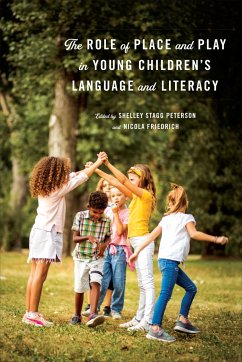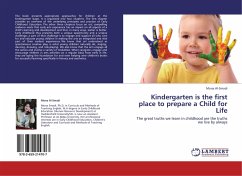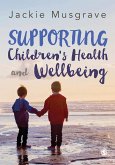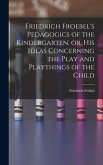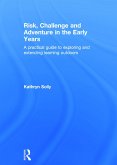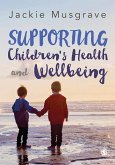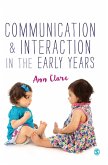Shelley Stagg Peterson, Nicola Friedrich
The Role of Place and Play in Young Children's Language and Literacy
Herausgeber: Stagg Peterson, Shelley; Friedrich, Nicola
Shelley Stagg Peterson, Nicola Friedrich
The Role of Place and Play in Young Children's Language and Literacy
Herausgeber: Stagg Peterson, Shelley; Friedrich, Nicola
- Gebundenes Buch
- Merkliste
- Auf die Merkliste
- Bewerten Bewerten
- Teilen
- Produkt teilen
- Produkterinnerung
- Produkterinnerung
This book brings notions of play and place as cultural constructions into conversations about language and literacy.
Andere Kunden interessierten sich auch für
![Kindergarten is the first place to prepare a Child for Life Kindergarten is the first place to prepare a Child for Life]() Mona Al-SmadiKindergarten is the first place to prepare a Child for Life32,99 €
Mona Al-SmadiKindergarten is the first place to prepare a Child for Life32,99 €![Supporting Children's Health and Wellbeing Supporting Children's Health and Wellbeing]() Jackie MusgraveSupporting Children's Health and Wellbeing90,99 €
Jackie MusgraveSupporting Children's Health and Wellbeing90,99 €![Friedrich Froebel's Pedagogics of the Kindergarten, or, His Ideas Concerning the Play and Playthings of the Child Friedrich Froebel's Pedagogics of the Kindergarten, or, His Ideas Concerning the Play and Playthings of the Child]() Friedrich FröbelFriedrich Froebel's Pedagogics of the Kindergarten, or, His Ideas Concerning the Play and Playthings of the Child38,99 €
Friedrich FröbelFriedrich Froebel's Pedagogics of the Kindergarten, or, His Ideas Concerning the Play and Playthings of the Child38,99 €![Risk, Challenge and Adventure in the Early Years Risk, Challenge and Adventure in the Early Years]() Kathryn SollyRisk, Challenge and Adventure in the Early Years159,99 €
Kathryn SollyRisk, Challenge and Adventure in the Early Years159,99 €![Supporting Children's Health and Wellbeing Supporting Children's Health and Wellbeing]() Jackie MusgraveSupporting Children's Health and Wellbeing31,99 €
Jackie MusgraveSupporting Children's Health and Wellbeing31,99 €![Communication and Interaction in the Early Years Communication and Interaction in the Early Years]() Ann ClareCommunication and Interaction in the Early Years112,99 €
Ann ClareCommunication and Interaction in the Early Years112,99 €![The Kindergarten and its Relation to Elementary Education The Kindergarten and its Relation to Elementary Education]() Ada Van Stone HarrisThe Kindergarten and its Relation to Elementary Education28,99 €
Ada Van Stone HarrisThe Kindergarten and its Relation to Elementary Education28,99 €-
-
-
This book brings notions of play and place as cultural constructions into conversations about language and literacy.
Produktdetails
- Produktdetails
- Verlag: University of Toronto Press
- Seitenzahl: 282
- Erscheinungstermin: 31. März 2022
- Englisch
- Abmessung: 229mm x 152mm x 25mm
- Gewicht: 508g
- ISBN-13: 9781487529215
- ISBN-10: 148752921X
- Artikelnr.: 61381505
- Herstellerkennzeichnung
- Libri GmbH
- Europaallee 1
- 36244 Bad Hersfeld
- gpsr@libri.de
- Verlag: University of Toronto Press
- Seitenzahl: 282
- Erscheinungstermin: 31. März 2022
- Englisch
- Abmessung: 229mm x 152mm x 25mm
- Gewicht: 508g
- ISBN-13: 9781487529215
- ISBN-10: 148752921X
- Artikelnr.: 61381505
- Herstellerkennzeichnung
- Libri GmbH
- Europaallee 1
- 36244 Bad Hersfeld
- gpsr@libri.de
Shelley Stagg Peterson is a professor in the Department of Curriculum, Teaching, and Learning at the Ontario Institute for Studies in Education at University of Toronto. Nicola Friedrich is a postdoctoral fellow in the Department of Curriculum, Teaching, and Learning at the Ontario Institute for Studies in Education at University of Toronto.
List of Figures
1. Introduction: Playce-Based Language and Literacy Learning in Early
Childhood
Shelley Stagg Peterson and Nicola Friedrich
2. Valuing Rural and Indigenous Social Practices: Play as Placed Learning
in Kindergarten Classrooms
Karen Eppley, Shelley Stagg Peterson, and Denise Heppner
3. Seven Directions Early Learning for Indigenous Land Literacy Wisdom
Sharla Mskokii Peltier
4. Sámi Children’s Language Use, Play, and the Outdoors Through Teachers’
Lens
Kristina Belancic
5. Young Children Exploring Identities, Languages, and Cultures in a
Multicultural Place
Maria Cooper and Helen Hedges
6. Placing the Child’s Hands on the Land: Conceptualizing, Creating, and
Implementing Land-Based Teachings in a Play Space
Lori Huston and Stephanie Michano-Drover
7. Negotiating a Place to Belong in an Aotearoa New Zealand Playgroup
Mary M. Jacobs
8. The Importance of the Land, Language, Culture, Identity, and Learning in
Relation for Indigenous Children
Jeffrey Wood
9. If Writing Floats "on a Sea of Talk," How Best to Harness the Waves and
Currents of Place and Play?
Judy M. Parr
10. Scaffolding Community Literacy Practices in Kindergarten Classrooms
Nicola Friedrich
11. Children’s Engagement and Inquiry in Outdoors Contexts as Play- and
Place-Based Learning
Gisela Wajskop
12. Enriching Learning with the Richness Around Us
Christine Portier
13. Exploring Urban Place-Based Play as a Stimulus for "Language in Action"
and "Language as Reflection"
Janet Scull and Kim O’Grady
14. The Key Role of the Educator as a Conversational Partner in Play- and
Place-Based Learning
Janice Greenberg and Sharon Walker
15. Language Learning in the Garden: Discoveries from a Collaboration in a
North-Central Saskatchewan Indigenous Community
Laureen J. McIntyre, Laurie-ann M. Hellsten, and Tyler Bergen
16. Conclusion: Questions and Implications Arising from Playce-Based
Learning in Communities across Four Continents
Shelley Stagg Peterson
17. Places and Players: An Afterword
Michael Corbett
Contributors
Index
1. Introduction: Playce-Based Language and Literacy Learning in Early
Childhood
Shelley Stagg Peterson and Nicola Friedrich
2. Valuing Rural and Indigenous Social Practices: Play as Placed Learning
in Kindergarten Classrooms
Karen Eppley, Shelley Stagg Peterson, and Denise Heppner
3. Seven Directions Early Learning for Indigenous Land Literacy Wisdom
Sharla Mskokii Peltier
4. Sámi Children’s Language Use, Play, and the Outdoors Through Teachers’
Lens
Kristina Belancic
5. Young Children Exploring Identities, Languages, and Cultures in a
Multicultural Place
Maria Cooper and Helen Hedges
6. Placing the Child’s Hands on the Land: Conceptualizing, Creating, and
Implementing Land-Based Teachings in a Play Space
Lori Huston and Stephanie Michano-Drover
7. Negotiating a Place to Belong in an Aotearoa New Zealand Playgroup
Mary M. Jacobs
8. The Importance of the Land, Language, Culture, Identity, and Learning in
Relation for Indigenous Children
Jeffrey Wood
9. If Writing Floats "on a Sea of Talk," How Best to Harness the Waves and
Currents of Place and Play?
Judy M. Parr
10. Scaffolding Community Literacy Practices in Kindergarten Classrooms
Nicola Friedrich
11. Children’s Engagement and Inquiry in Outdoors Contexts as Play- and
Place-Based Learning
Gisela Wajskop
12. Enriching Learning with the Richness Around Us
Christine Portier
13. Exploring Urban Place-Based Play as a Stimulus for "Language in Action"
and "Language as Reflection"
Janet Scull and Kim O’Grady
14. The Key Role of the Educator as a Conversational Partner in Play- and
Place-Based Learning
Janice Greenberg and Sharon Walker
15. Language Learning in the Garden: Discoveries from a Collaboration in a
North-Central Saskatchewan Indigenous Community
Laureen J. McIntyre, Laurie-ann M. Hellsten, and Tyler Bergen
16. Conclusion: Questions and Implications Arising from Playce-Based
Learning in Communities across Four Continents
Shelley Stagg Peterson
17. Places and Players: An Afterword
Michael Corbett
Contributors
Index
List of Figures
1. Introduction: Playce-Based Language and Literacy Learning in Early
Childhood
Shelley Stagg Peterson and Nicola Friedrich
2. Valuing Rural and Indigenous Social Practices: Play as Placed Learning
in Kindergarten Classrooms
Karen Eppley, Shelley Stagg Peterson, and Denise Heppner
3. Seven Directions Early Learning for Indigenous Land Literacy Wisdom
Sharla Mskokii Peltier
4. Sámi Children’s Language Use, Play, and the Outdoors Through Teachers’
Lens
Kristina Belancic
5. Young Children Exploring Identities, Languages, and Cultures in a
Multicultural Place
Maria Cooper and Helen Hedges
6. Placing the Child’s Hands on the Land: Conceptualizing, Creating, and
Implementing Land-Based Teachings in a Play Space
Lori Huston and Stephanie Michano-Drover
7. Negotiating a Place to Belong in an Aotearoa New Zealand Playgroup
Mary M. Jacobs
8. The Importance of the Land, Language, Culture, Identity, and Learning in
Relation for Indigenous Children
Jeffrey Wood
9. If Writing Floats "on a Sea of Talk," How Best to Harness the Waves and
Currents of Place and Play?
Judy M. Parr
10. Scaffolding Community Literacy Practices in Kindergarten Classrooms
Nicola Friedrich
11. Children’s Engagement and Inquiry in Outdoors Contexts as Play- and
Place-Based Learning
Gisela Wajskop
12. Enriching Learning with the Richness Around Us
Christine Portier
13. Exploring Urban Place-Based Play as a Stimulus for "Language in Action"
and "Language as Reflection"
Janet Scull and Kim O’Grady
14. The Key Role of the Educator as a Conversational Partner in Play- and
Place-Based Learning
Janice Greenberg and Sharon Walker
15. Language Learning in the Garden: Discoveries from a Collaboration in a
North-Central Saskatchewan Indigenous Community
Laureen J. McIntyre, Laurie-ann M. Hellsten, and Tyler Bergen
16. Conclusion: Questions and Implications Arising from Playce-Based
Learning in Communities across Four Continents
Shelley Stagg Peterson
17. Places and Players: An Afterword
Michael Corbett
Contributors
Index
1. Introduction: Playce-Based Language and Literacy Learning in Early
Childhood
Shelley Stagg Peterson and Nicola Friedrich
2. Valuing Rural and Indigenous Social Practices: Play as Placed Learning
in Kindergarten Classrooms
Karen Eppley, Shelley Stagg Peterson, and Denise Heppner
3. Seven Directions Early Learning for Indigenous Land Literacy Wisdom
Sharla Mskokii Peltier
4. Sámi Children’s Language Use, Play, and the Outdoors Through Teachers’
Lens
Kristina Belancic
5. Young Children Exploring Identities, Languages, and Cultures in a
Multicultural Place
Maria Cooper and Helen Hedges
6. Placing the Child’s Hands on the Land: Conceptualizing, Creating, and
Implementing Land-Based Teachings in a Play Space
Lori Huston and Stephanie Michano-Drover
7. Negotiating a Place to Belong in an Aotearoa New Zealand Playgroup
Mary M. Jacobs
8. The Importance of the Land, Language, Culture, Identity, and Learning in
Relation for Indigenous Children
Jeffrey Wood
9. If Writing Floats "on a Sea of Talk," How Best to Harness the Waves and
Currents of Place and Play?
Judy M. Parr
10. Scaffolding Community Literacy Practices in Kindergarten Classrooms
Nicola Friedrich
11. Children’s Engagement and Inquiry in Outdoors Contexts as Play- and
Place-Based Learning
Gisela Wajskop
12. Enriching Learning with the Richness Around Us
Christine Portier
13. Exploring Urban Place-Based Play as a Stimulus for "Language in Action"
and "Language as Reflection"
Janet Scull and Kim O’Grady
14. The Key Role of the Educator as a Conversational Partner in Play- and
Place-Based Learning
Janice Greenberg and Sharon Walker
15. Language Learning in the Garden: Discoveries from a Collaboration in a
North-Central Saskatchewan Indigenous Community
Laureen J. McIntyre, Laurie-ann M. Hellsten, and Tyler Bergen
16. Conclusion: Questions and Implications Arising from Playce-Based
Learning in Communities across Four Continents
Shelley Stagg Peterson
17. Places and Players: An Afterword
Michael Corbett
Contributors
Index

